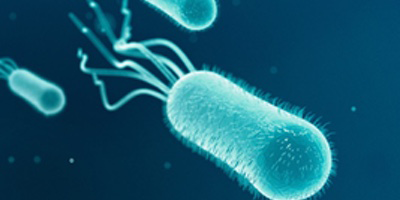Bacterial Superfluids
The presence of bacteria can alter a fluid’s hydrodynamic properties. A new study shows that the collective motion of swimming bacteria can lower the viscosity of a fluid to zero, mimicking a superfluid like liquid helium. For highly active bacteria, the viscosity can even become negative, meaning the swimmers are pushing the fluid along. The results suggest that energy spent by bacteria in swimming could be harvested to drive tiny mechanical devices.
Viscosity is a fluid’s resistance to shear stress, or some other deforming process. Microscopically, this internal “drag” arises when nearby elements of the fluid move at different speeds (a velocity gradient). A swimming organism can alter a fluid’s dynamics through its propelling motion, locally changing the fluid flow. Models suggest that pusher-swimmers—organisms that force fluid to flow out, away from their tails—will lower the viscosity by aligning themselves such that their pushing contributes to the velocity gradient. Recent experiments have confirmed this, but now a research team has shown just how large the effect can be.
Héctor López of the University Paris-Sud in France and his colleagues worked with E. coli bacteria, a type of pusher-swimmer. The team placed fluid-bacteria mixtures in a vessel that applies shear stress through a rotating outer wall. For low to moderate stress values, the bacteria reduced the viscosity, as predicted. When the team “doped” the bacteria with extra nutrients, their higher activity led to zero—and even below zero—viscosity. The negative values imply that bacteria might be induced to drag around a tiny rotor that could power a small device, like a microfluidic pump.
This research is published in Physical Review Letters.
–Michael Schirber





